The Best (and the Weirdest) of NAMM 2014
NAMM is to music gear what CES is to consumer electronics, E3 is to video […]
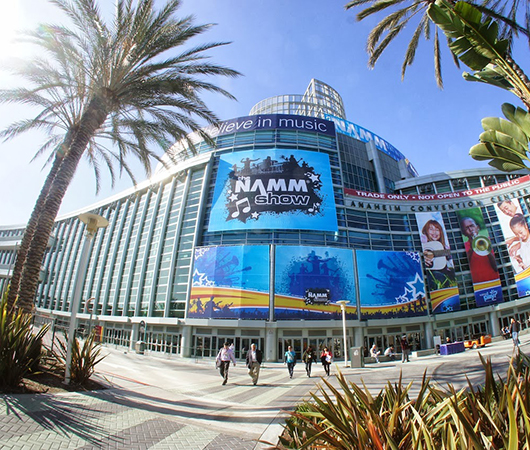
NAMM is to music gear what CES is to consumer electronics, E3 is to video games, and the ’80s were to personal finance: spectacularly overwrought excess, as companies large and small blow huge chunks of their marketing budgets to flaunt new gear. Each year, the event takes place over the course of four days in Anaheim, California, under the big-eared shadow of Disneyland. It’s generally overrun by suited sales folk and aging rockers whose hairlines have receded into their bellies, along with gearheads who fly in from around the world to get face-to-face (and hand-to-knob) time with the people that make their musical tools. As part of the latter contingent, we picked through the roughly six million mandolins and generic DJ controllers—and came across some oddly memorable happenings in the process—but ultimately honed in on the most exciting gear NAMM 2014 had to offer.
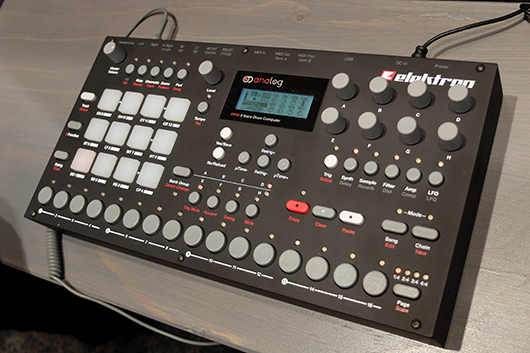
Elektron Analog Rytm
Hot on the heels of its Analog Keys synthesizer, Elektron unveiled its newest drum machine at NAMM, the de-voweled Analog Rytm. It brings MPC-style drum pads to the company’s iconic box design, making for a slightly wider footprint. Analog Rytm combines an eight-voice analog drum machine with sample playback, and allows for realtime playing via the 4×3 grid of velocity- and pressure-sensitive pads. It’s got an analog multimode filter and analog distortion circuit (deployable per voice), along with an analog compressor and distortion on the master voice. Various effects and Elektron’s rock-solid step sequencer, along with some super-cool performance-oriented beat controls, make this a drum machine to drool over.
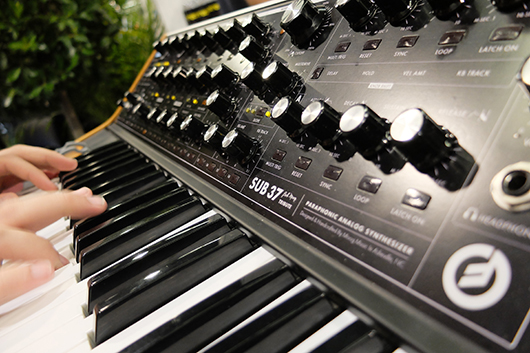
Moog Sub 37
Building upon the beefy foundation of its own Sub Phatty, Moog‘s Sub 37 is the celebrated company’s newest analog synthesizer. Think of it as a fatty Phatty: With a keyboard extended to 37 keys, the Sub 37 has same multi-pole Moog filter, along with Multidrive circuitry and a variable feedback control for even more layers of rich, saturated overdriven tones. The larger size provides more space on the front panel, which brings with it many more controls for editing of most of the functions that were hidden on the Sub Phatty. This makes it more programmable and immediate, and 256 on-board memory slots let users save plenty of their own tweaked sounds. Where the Sub Phatty was monophonic, the Sub 37 is paraphonic, which means that although they share the same single VCA and VCF, you can play each of its two oscillators independently. It’ll cost $1495 and should be available soon.
A pair of enthusiastic NAMM attendees

Roland Aira
This is a bit awkward, but Roland‘s Aira—which may be a thing, or, uh, multiple things—looks really cool. It’s too early to tell, certainly, but Aira may finally represent a return to form for the Japanese company, which of course has classic machines like the 808, 909, and Juno under its belt. We’d love to say more about it, but an embargo prevents us from doing so until next month. Stay tuned.
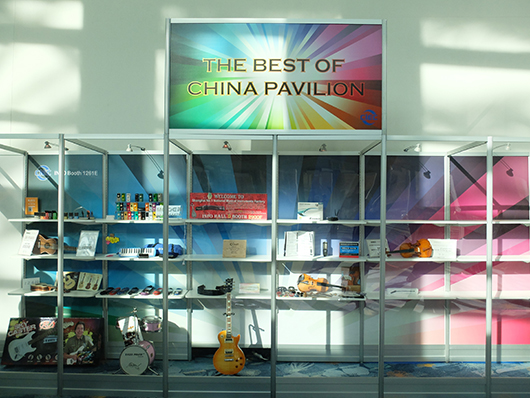
China Pavilion
It was the best of China Pavilion, it was the worst of China Pavilion. It was China Pavilion, the saddest pavilion of them all.
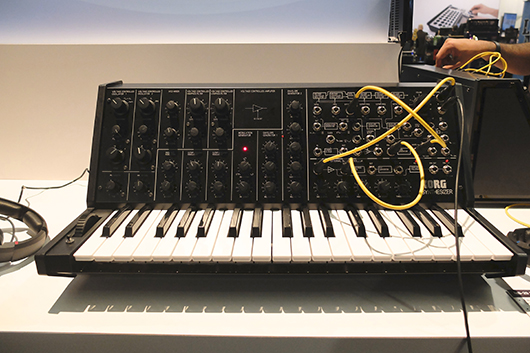
Korg MS-20 Kit
Last year, Korg re-released its legendary MS-20 synthesizer in the form of the MS-20 mini, which was essentially a perfect recreation of the original layout and circuitry in a smaller form factor. In 2014, the company has upped the ante, at least physically: everything is back in full size, from the case to the keys to the 1/4″ jacks on the patch bay. Much like the mini, it allows for both MIDI and USB MIDI input. And here’s the weird part: users assemble it themselves. There’s no soldering involved, just a box full of pre-soldered parts that can be put together in an hour or two using a screwdriver. Street price is $1399.99, and it’ll be available as a limited-edition release in March.
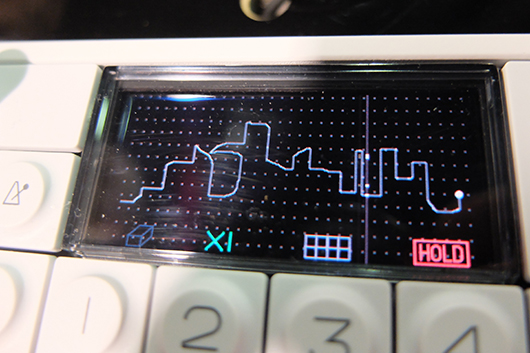
Teenage Engineering OP-1 Update
The idea of a “firmware update” doesn’t generally spark much excitement, but not so with Teenage Engineering‘s OP-1. The Swedish company used NAMM to unveil the latest feature additions to its flagship portable synthesizer, and they didn’t disappoint. The new “Sketch” synth engine essentially turns the OP-1 into an Etch-a-Sketch, allowing users to draw sequences manually using the machine’s knobs, creating weirdo rhythms and melodies on or off the grid. (To erase and start over, one only needs to shake the synth, of course.) There’s also a new sound designer based on the DBOX drum synth, along with a much-requested global tuning feature that lets users detune the synthesizer as they wish, making it decidedly more band-friendly.
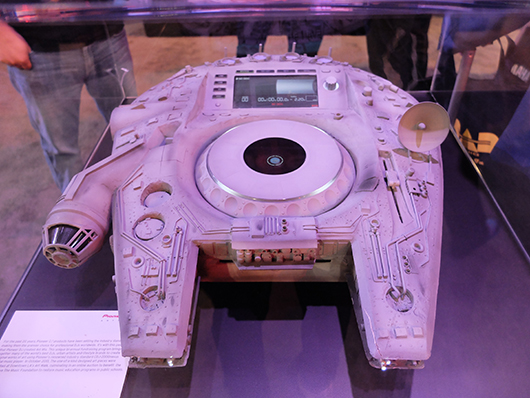
Pioneer CDJ-2000 Millennium Falcon
Because Millennium Falcon.
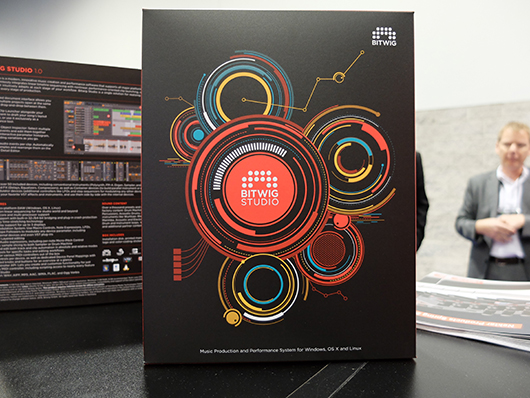
Bitwig Studio
It’s been in development for ages, and now it’s finally (almost) here—namely Bitwig Studio, which has been touted as a potential competitor to Ableton Live’s throne in the DAW game. The software won’t officially be hitting shelves until March 26th, but it’s getting close; retail delivery dates have been set and boxes have been printed. Bitwig’s NAMM booth was aflutter with activity, as MIDI controller manufacturers like Livid Instruments, Nektar, and Novation were all showing off their integrated controller mappings for the software. Indeed, this promises to be one of its big selling points—all-in, non-denominational third-party support and accessible scripting for MIDI controllers. Along with tons of modulation power, super flexible window layouts, and hybrid tracks that mix audio and MIDI data, the time for reckoning is drawing near.
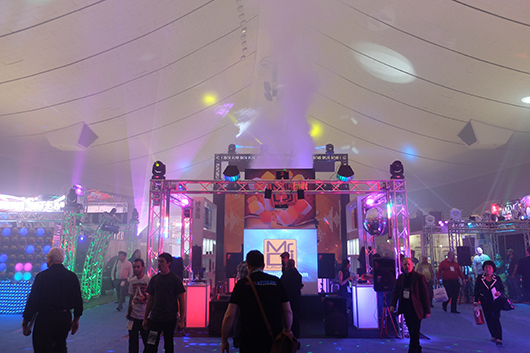
Lasers
There seems to be no end to the companies producing lasers and LED lighting equipment for clubs, as evidenced by the sports stadium-sized hall reserved for them at NAMM 2014. The aggregated aural and visual noise made the rest of the show feel sedate by comparison, and the hall was mostly full of old people, which created an extremely unique vibe.
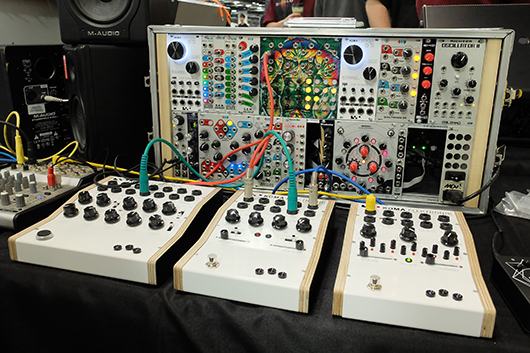
Modular Madness
The deep recesses of NAMM—namely Hall E, also known as “the basement”—have become the de facto hub for all things modular. This year the likes of Harvestman, WMD, 4MS, and Koma Elektronik set up shop in a joint booth, showing off new modules to expand the possibilities of modular synthesis. Make Noise’s new reverb, Tiptop’s Circadian Rhythm sequencer, and Pittsburg Modular’s Phase Shifter were also among the many modular standouts at the show.

